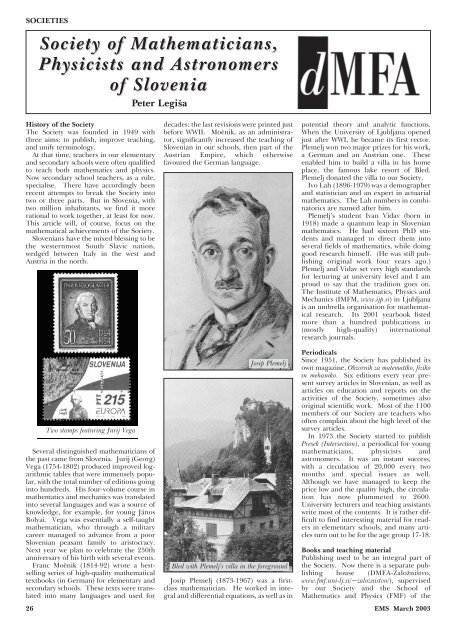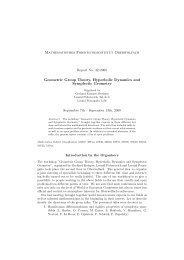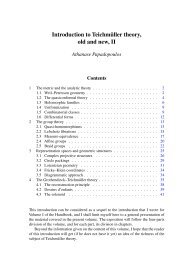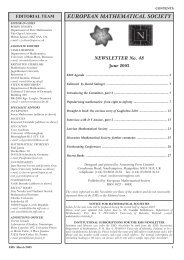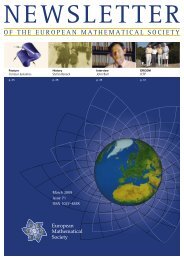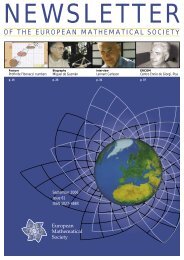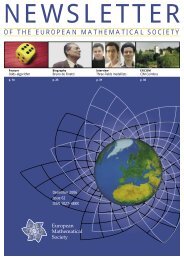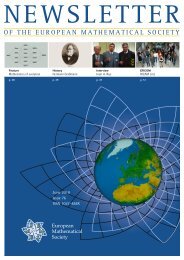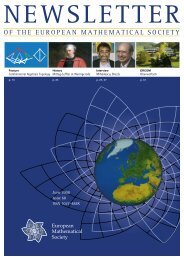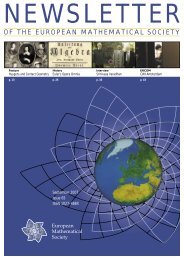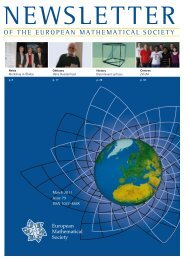March - European Mathematical Society Publishing House
March - European Mathematical Society Publishing House
March - European Mathematical Society Publishing House
Create successful ePaper yourself
Turn your PDF publications into a flip-book with our unique Google optimized e-Paper software.
SOCIETIES<br />
History of the <strong>Society</strong><br />
The <strong>Society</strong> was founded in 1949 with<br />
three aims: to publish, improve teaching,<br />
and unify terminology.<br />
At that time, teachers in our elementary<br />
and secondary schools were often qualified<br />
to teach both mathematics and physics.<br />
Now secondary school teachers, as a rule,<br />
specialise. There have accordingly been<br />
recent attempts to break the <strong>Society</strong> into<br />
two or three parts. But in Slovenia, with<br />
two million inhabitants, we find it more<br />
rational to work together, at least for now.<br />
This article will, of course, focus on the<br />
mathematical achievements of the <strong>Society</strong>.<br />
Slovenians have the mixed blessing to be<br />
the westernmost South Slavic nation,<br />
wedged between Italy in the west and<br />
Austria in the north.<br />
Several distinguished mathematicians of<br />
the past came from Slovenia. Jurij (Georg)<br />
Vega (1754-1802) produced improved logarithmic<br />
tables that were immensely popular,<br />
with the total number of editions going<br />
into hundreds. His four-volume course in<br />
mathematics and mechanics was translated<br />
into several languages and was a source of<br />
knowledge, for example, for young János<br />
Bolyai. Vega was essentially a self-taught<br />
mathematician, who through a military<br />
career managed to advance from a poor<br />
Slovenian peasant family to aristocracy.<br />
Next year we plan to celebrate the 250th<br />
anniversary of his birth with several events.<br />
Franc Moènik (1814-92) wrote a bestselling<br />
series of high-quality mathematical<br />
textbooks (in German) for elementary and<br />
secondary schools. These texts were translated<br />
into many languages and used for<br />
26<br />
<strong>Society</strong> of Mathematicians,<br />
Physicists and Astronomers<br />
Astronomers<br />
of Slovenia<br />
Two stamps featuring Jurij Vega<br />
Peter Legiša<br />
decades: the last revisions were printed just<br />
before WWII. Moènik, as an administrator,<br />
significantly increased the teaching of<br />
Slovenian in our schools, then part of the<br />
Austrian Empire, which otherwise<br />
favoured the German language.<br />
Josip Plemelj<br />
Bled with Plemelj’s villa in the foreground<br />
Josip Plemelj (1873-1967) was a firstclass<br />
mathematician. He worked in integral<br />
and differential equations, as well as in<br />
potential theory and analytic functions.<br />
When the University of Ljubljana opened<br />
just after WWI, he became its first rector.<br />
Plemelj won two major prizes for his work,<br />
a German and an Austrian one. These<br />
enabled him to build a villa in his home<br />
place, the famous lake resort of Bled.<br />
Plemelj donated the villa to our <strong>Society</strong>.<br />
Ivo Lah (1896-1979) was a demographer<br />
and statistician and an expert in actuarial<br />
mathematics. The Lah numbers in combinatorics<br />
are named after him.<br />
Plemelj’s student Ivan Vidav (born in<br />
1918) made a quantum leap in Slovenian<br />
mathematics. He had sixteen PhD students<br />
and managed to direct them into<br />
several fields of mathematics, while doing<br />
good research himself. (He was still publishing<br />
original work four years ago.)<br />
Plemelj and Vidav set very high standards<br />
for lecturing at university level and I am<br />
proud to say that the tradition goes on.<br />
The Institute of Mathematics, Physics and<br />
Mechanics (IMFM, www.ijp.si) in Ljubljana<br />
is an umbrella organisation for mathematical<br />
research. Its 2001 yearbook listed<br />
more than a hundred publications in<br />
(mostly high-quality) international<br />
research journals.<br />
Periodicals<br />
Since 1951, the <strong>Society</strong> has published its<br />
own magazine, Obzornik za matematiko, fiziko<br />
in mehaniko. Six editions every year present<br />
survey articles in Slovenian, as well as<br />
articles on education and reports on the<br />
activities of the <strong>Society</strong>, sometimes also<br />
original scientific work. Most of the 1100<br />
members of our <strong>Society</strong> are teachers who<br />
often complain about the high level of the<br />
survey articles.<br />
In 1973 the <strong>Society</strong> started to publish<br />
Presek (Intersection), a periodical for young<br />
mathematicians, physicists and<br />
astronomers. It was an instant success,<br />
with a circulation of 20,000 every two<br />
months and special issues as well.<br />
Although we have managed to keep the<br />
price low and the quality high, the circulation<br />
has now plummeted to 2600.<br />
University lecturers and teaching assistants<br />
write most of the contents. It is rather difficult<br />
to find interesting material for readers<br />
in elementary schools, and many articles<br />
turn out to be for the age group 17-18.<br />
Books and teaching material<br />
<strong>Publishing</strong> used to be an integral part of<br />
the <strong>Society</strong>. Now there is a separate publishing<br />
house (DMFA-Zaloništvo,<br />
www.fmf.uni-lj.si/~zaloznistvo/), supervised<br />
by our <strong>Society</strong> and the School of<br />
Mathematics and Physics (FMF) of the<br />
EMS <strong>March</strong> 2003


